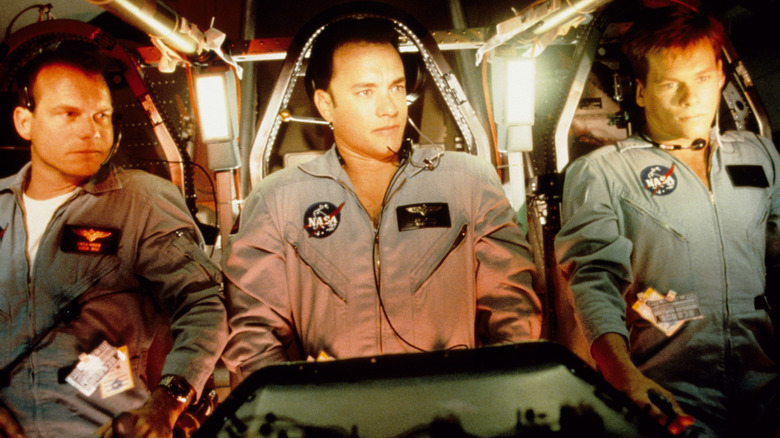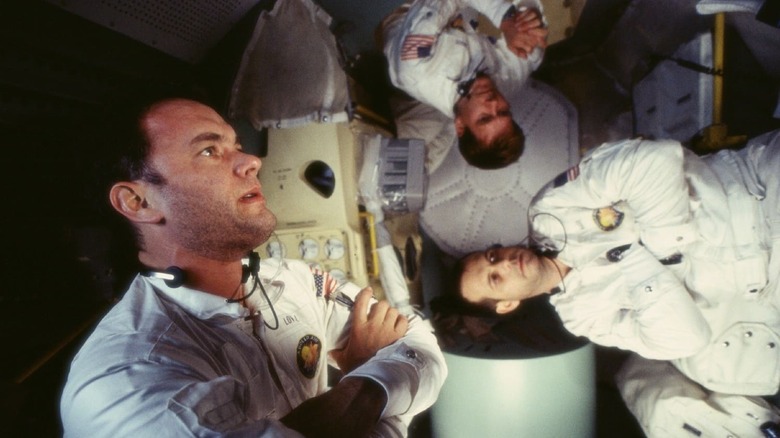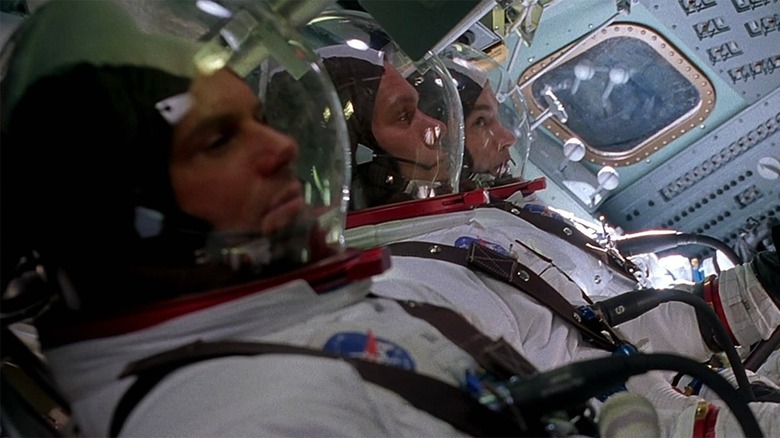How Apollo 13's VFX Team Faked A Rocket Launch With A Fire Extinguisher
Ron Howard's 1995 film "Apollo 13" is an effective thriller even when forearmed with the knowledge that the three astronauts depicted returned to Earth okay. For those unfamiliar with the Apollo 13 mission, in April of 1970, Jim Lovell, Jack Swigert, and Fred Haise took a shuttle into space, hoping to land on the moon. An electrical problem, however, caused an explosion on the craft, and the astronauts lost a great deal of their oxygen supply. With resources nil and communication limited, the astronauts had to find a way to survive in space and return to Earth alive. Sadly, they didn't get to walk on the moon.
In Howard's film, the astronauts were played by Tom Hanks, Kevin Bacon, and Bill Paxton, while Ed Harris played their contact back at NASA. The film was nominated for nine Academy Awards, including Best Picture, and won two for Best Sound and Best Editing. It lost Best Visual Effects to "Babe."
Robert Legato was in charge of special effects, and both he and Howard felt that using stock footage of actual shuttle launches would look tacky. Howard instructed Legato to shoot and pace the shuttle launch sequences as one might a Martin Scorsese movie. Impressively, Legato filmed one of the wide shots of the shuttle using an off-the-shelf Revell-brand shuttle model. The shots of the model were digitized and altered to look more authentic. One wouldn't be able to tell that it wasn't the real deal.
In 2019, Legato spoke with Vulture about "Apollo 13," specifically the larger, 40-foot model he built for the film's previsualization phase. For the "rocket smoke," Legato just used a run-of-the-mill fire extinguisher.
The 40-foot shuttle
Previsualization is a phase of production that serves as a camera and/or VFX "rehearsal." Technicians and photographers will often film zero-budget sequences without sets and/or using stand-ins for the actors to get a sense of where a camera will go and how editing will function in the final film. It's like the next step after a storyboard: build something to see if it works. In the modern era, most previsualization is done via computers or animation, but physical models were needed in 1995. Legato explained a little about previs for "Apollo 13," saying:
"In the previs phase — which is 'previsualization' — we would use the miniature models to build out the storyboard that we later break apart into pieces that comprise the sequences. These days, I can use a VR tool to put together a storyboard that lets me visualize the scene on a more accurate scale. However, back when doing 'Apollo 13,' we had to literally build a miniature mock-up set shaped out of foam core to visualize the set in previs. So instead of building a 400-foot rocket model, we did a 40-foot version that's more practical to imagine scenes around."
Once the 40-foot model was built, Legato filmed the scene using a tiny, consumer-grade spy camera. Such cameras were, in 1995, about as big as a chunky pen or tube of lipstick. Note that the quality of the image wasn't of much concern during previs, as Legato just needed to get the correct angles on his model. He held the camera and hovered it next to a styrofoam model of the NASA scaffolding and shuttle. Movie magic.
The fire extinguisher
Once Legato had the footage of his model, he could edit together a sequence, or experiment with different visuals. Would a shaky cam, for instance, look better or worse than a still one? Then he could blow in some smoke, which is where the fire extinguisher came in. Legato said:
"For example, we would add a shaking camera in the style of a real spaceship launch to breathe life into the footage. For things like the Apollo 'rocket smoke,' we literally used a fire extinguisher to replicate what the launch looks like and fool the eye. So we used close-up shots of it 'launching' into the same direction in order to mimic that grand effect of the real-life scene. To the viewer's eye, it looks like we built a rocket ship, which is obviously too expensive and impractical for a scene. Not to mention, dangerous!"
Legato also famously filmed the "Apollo 13" weightless scenes on board a high-altitude KC-135 airplane which would make sharp dives for about 26 seconds at a time, letting the cast actually float for a few moments. Only a few crew members got sick from the constant turbulence. Ultimately, almost four hours of zero-G footage was shot, which required 612 dives. There were a few notable instances of CGI, but Legato stuck with practical and photographic effects for the bulk of the film.
The infamous shot of astronaut urine spraying out into space was initially visualized using CGI, but Legato filmed a mere spray bottle instead. The urine was, in fact, Evian water.


